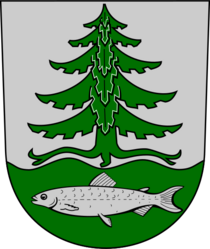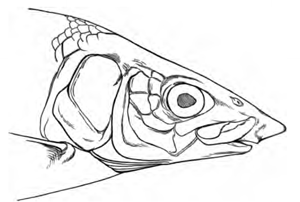Coregonus lavaretus facts for kids
Quick facts for kids Coregonus lavaretus |
|
|---|---|
 |
|
| European whitefish (Coregonus lavaretus) | |
| Conservation status | |
| Scientific classification | |
| Genus: |
Coregonus
|
| Species: |
lavaretus
|
| Synonyms | |
|
Coregonus oxyrinchus (Linnaeus, 1758) |
|
The Coregonus lavaretus is a type of freshwater whitefish. It belongs to the family called Salmonidae, which also includes salmon and trout. This fish is the main example for its group, Coregonus.
Scientists sometimes have different ideas about how many types of Coregonus lavaretus there are. They also disagree on how many different species are in the whole Coregonus group.
Contents
Lavaret: A Special French Fish
In one way of looking at it, the Coregonus lavaretus, also called the lavaret, is a special fish found only in Lake Bourget and Lake d’Aiguebelette in France. It used to live in Lake Geneva too. Some scientists believe there are many different kinds of whitefish in Europe's lakes, rivers, and even salty waters.
European Whitefish: A Widespread Group
In a broader sense, Coregonus lavaretus is known as the common whitefish or European whitefish. This group of fish lives across central and northern Europe all the way to Siberia. It's often called the C. lavaretus complex because it includes many types of whitefish that some people think are separate species.
These fish can look different and have different habits. For example, some eat different foods, grow in different ways, or travel to different places. Genetic studies suggest that these different types of whitefish appeared after the last Ice Age. Similar types of fish have developed independently in different lakes.
What Does a European Whitefish Look Like?
European whitefish can vary a lot, but they generally have a body that gets thinner towards the tail. Their upper jaw sticks out a little. Like other fish in the salmon family, they have a soft, fleshy fin on their back.
Their snout is short and pointed. This helps tell them apart from two other similar fish in northern Europe: the vendace (Coregonus albula) and the peled (Coregonus peled). The vendace has a lower jaw that sticks out, while the peled has jaws that are the same length.
The back of the European whitefish is usually bluish-green or brownish. Its sides are silver, and its belly is white. Their fins are dark grey. This fish usually doesn't grow longer than 55 cm (about 22 inches) or weigh more than 2 kg (about 4.4 pounds).
How Do European Whitefish Live?
European whitefish mostly eat small creatures that live on the bottom of the water. They also eat tiny animals floating in the water called zooplankton. Bigger fish might also catch insects from the water's surface or eat baby fish.
They lay their eggs in the autumn, usually between September and November. The exact time depends on how warm the water is. Different groups of whitefish living in the same area might lay their eggs at different times. Many populations in seas and lakes swim up rivers to lay their eggs. However, other groups stay in lakes or the sea even when it's time to breed.
Houting: A Fish Thought to Be Lost
The houting (Coregonus oxyrhinchus) is another European species of whitefish in the salmon family. For a long time, people thought it was extinct. It used to live in the rivers and river mouths that flow into the North Sea.
The houting looks different from other Coregonus fish. It has a long, pointed snout and a mouth that points downwards. It also has a different number of gill rakers, which are comb-like structures in their gills. The houting once lived in Belgium, France, Germany, the Netherlands, and England.
In 2023, scientists did DNA tests. They found that the houting is genetically the same as Coregonus lavaretus. This means it's not a separate species and therefore not extinct.
The Houting's Special Status
There's been some debate about whether the whitefish living in the Wadden Sea area of Denmark (called snæbel in Danish) are the same as the houting that disappeared from other parts of the North Sea. Like the older population, the Danish fish have a long, pointed snout and a downward-pointing mouth. They are also anadromous, meaning they spend most of their adult lives in coastal waters but swim into rivers to breed. This ability to live in full saltwater for a long time is special for the houting.
The Danish houting is part of the widespread Coregonus lavaretus group. Scientists couldn't compare its DNA to the extinct houting because there weren't enough samples of the old fish. However, the Danish houting has some small genetic differences compared to other fish in the C. lavaretus group. It also looks and lives a bit differently, making it an important group for evolution.
Sometimes, different types of Coregonus fish have mixed together because humans moved them around. Some researchers believe that the differences between houting populations are not big enough to make them separate species. They think that no species actually went extinct. The main reason for treating the Danish houting and the extinct houting as separate was the number of gill rakers. However, this number can change a lot within Coregonus fish, even in the same group. So, gill raker numbers are not always a good way to tell how closely related fish are.
Some people still think the differences in gill rakers are enough to call them separate species. They believe the last true houting was caught in the Rhine river in 1940. Early studies showed no overlap in gill raker numbers between the two groups. But later studies found some overlap, meaning the numbers can be similar.
A big project, partly funded by the European Union, worked to bring back the Danish houting from 2005 to 2013. They are still watching the fish and managing birds like the great cormorant that eat them. By 2019, over €20 million had been spent on protecting this fish.
The only remaining natural and important population of Danish houting is in the Vidå River. In 2014, there were about 3,500 adult fish. Scientists don't know much about where they lay eggs or what their young need. Despite the project, their numbers were still going down, causing fears they might disappear completely. However, after years of decline, the number of adult Danish houtings increased to about 4,000 in 2018–19. Most of these fish were in the Vidå, with fewer in the Ribe River, but both groups were growing.
Fish from the Danish population have been used to bring houting back to other rivers like the Eider and Elbe. On October 24, 2023, researchers in Belgium found a live houting in the Scheldt river. This was a surprise because the species was thought to be extinct in Belgium for over 100 years. The fish might have swum there from the Rhine population.
The European Union's Habitats Directive protects a species listed as Coregonus oxyrhynchus for its populations in certain parts of the North Sea.
As mentioned, in 2023, DNA analysis showed that the houting is genetically the same as Coregonus lavaretus, meaning it is not extinct.




